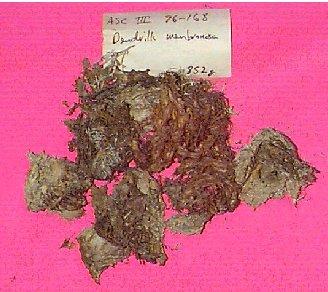3 December, 1996
One of the Navy Pilots, JD Washburn, asked Bill if he could spend the day
helping in the lab. He told us he planned to go to medical school and wanted
to brush up on his chemistry. Since we are backlogged with samples that need
to be freeze dried, Bill welcomed the offer of help and asked me to show JD
what needed to be done.
We started with the sponge in the picture, an 860-gram Dendrilla sample.
Our ultimate goal is to determine if the sponge produces chemicals that
defend it in some way. We know water isn't protecting the animal so we will
remove it. This is lengthy process because it needs to be accomplish it
without destroying other compounds.
Our first step was to cool the sample to minus 20 degrees. This would lock
the parcticles of the sponge into a solid matrix and allow the water to be
removed without causing physical or chemical changes. The frozen mass was
then put into a vacuum chamber that continually evacuated all
non-condensable gases. This reduced the resistance a water molecule would
encounter in migrating away from the sample. At this low pressure, the heat
from the room would be enough to drive the water molecules away from the
sponge. As they moved toward the low-pressure areas in the vacuum system,
they encountered a condenser where the temperature was minus 70 degrees. At
this temperature, the water would freeze and could be removed it as a chunk
of ice.
JD was anxious to help but he didn't want to stay until the process was
completed. It took five days for all of the water to be removed. When it
was, 96% of the animal's mass was gone. It looked like the picture on the
right.
This is the same process used to make instant coffee and many other freeze
dried foods. Here it's the first step in our search for natural products. We
have collected over two hundred different organisms that need to be
analyzed. It's going to be a long project and we could use a few more
chemists?

Jim Mastrow's underwater photo of dendrilla

The Dendrilla sample after being freeze dried.
Contact the TEA in the field at
.
If you cannot connect through your browser, copy the
TEA's e-mail address in the "To:" line of
your favorite e-mail package.
|
